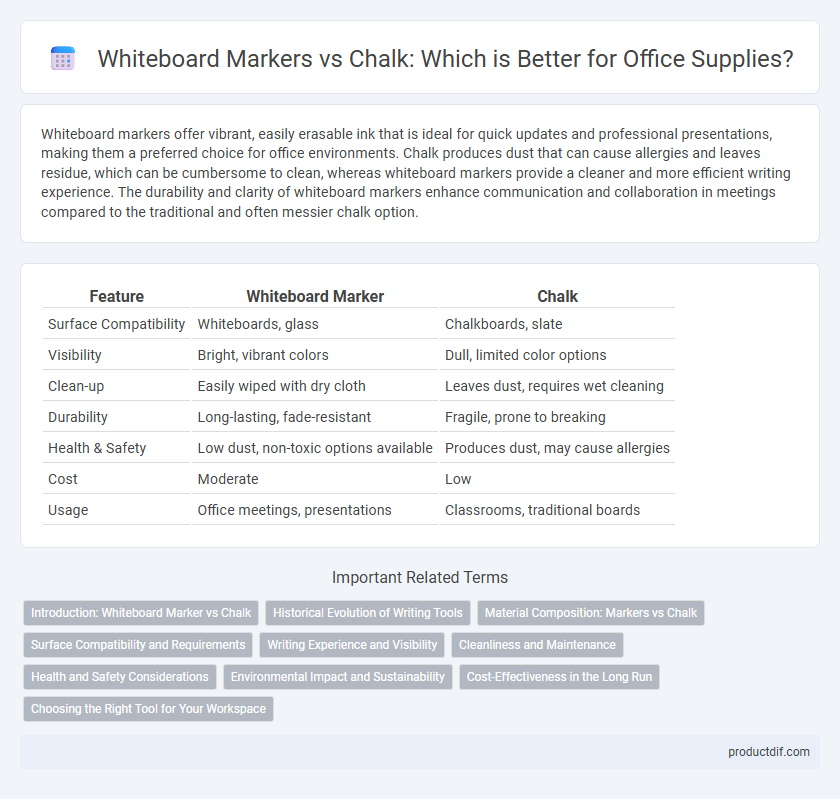Whiteboard markers offer vibrant, easily erasable ink that is ideal for quick updates and professional presentations, making them a preferred choice for office environments. Chalk produces dust that can cause allergies and leaves residue, which can be cumbersome to clean, whereas whiteboard markers provide a cleaner and more efficient writing experience. The durability and clarity of whiteboard markers enhance communication and collaboration in meetings compared to the traditional and often messier chalk option.
Table of Comparison
| Feature | Whiteboard Marker | Chalk |
|---|---|---|
| Surface Compatibility | Whiteboards, glass | Chalkboards, slate |
| Visibility | Bright, vibrant colors | Dull, limited color options |
| Clean-up | Easily wiped with dry cloth | Leaves dust, requires wet cleaning |
| Durability | Long-lasting, fade-resistant | Fragile, prone to breaking |
| Health & Safety | Low dust, non-toxic options available | Produces dust, may cause allergies |
| Cost | Moderate | Low |
| Usage | Office meetings, presentations | Classrooms, traditional boards |
Introduction: Whiteboard Marker vs Chalk
Whiteboard markers offer vibrant, smudge-resistant ink suitable for smooth surfaces, enhancing visibility and ease of use compared to traditional chalk. Chalk produces dust, can be messy, and tends to wear down quickly but remains cost-effective and compatible with chalkboards. Choosing between whiteboard markers and chalk depends on the writing surface, desired clarity, and maintenance preferences in office environments.
Historical Evolution of Writing Tools
Whiteboard markers and chalk represent distinct stages in the historical evolution of writing tools, transitioning from ancient slate-based methods to modern, erasable ink technologies. Chalk, used for centuries on blackboards, offered simplicity and affordability but suffered from dust and limited color options. Whiteboard markers introduced a cleaner, more versatile alternative with vivid colors and smooth application, revolutionizing office and classroom communication.
Material Composition: Markers vs Chalk
Whiteboard markers are composed mainly of non-toxic, alcohol-based ink encased in plastic barrels, offering smooth, vibrant writing that is easily erasable on glossy surfaces. Chalk is typically made from calcium carbonate or calcium sulfate, producing dust during use and leaving a more textured, less precise mark on chalkboards. The material differences influence durability, residue, and environmental impact, making markers preferable for clean, modern office environments while chalk suits traditional settings.
Surface Compatibility and Requirements
Whiteboard markers are designed specifically for non-porous surfaces like glass, whiteboards, and laminated sheets, providing vibrant, easily erasable marks without residue. Chalk works best on porous surfaces such as chalkboards and concrete, leaving a dusty finish that can be less precise and prone to smudging. Selecting between whiteboard markers and chalk depends on the surface compatibility and cleaning requirements of the workspace.
Writing Experience and Visibility
Whiteboard markers provide smooth gliding ink that dries quickly and offers high contrast visibility on glossy surfaces, enhancing readability in meetings and presentations. Chalk produces a textured, matte finish with less vibrant colors and often generates dust, which can affect clarity and cause allergies. Markers outperform chalk in consistency, allowing for clean, precise lines that improve overall writing experience and visual impact.
Cleanliness and Maintenance
Whiteboard markers offer superior cleanliness compared to chalk, as they produce no dust and minimize residue on surfaces and surrounding areas. Maintenance of whiteboards involves simple wiping with a dry or damp cloth, whereas chalkboards require frequent scrubbing to remove chalk buildup and prevent ghosting. Choosing whiteboard markers reduces airborne particles, benefiting indoor air quality and reducing cleaning efforts in office environments.
Health and Safety Considerations
Whiteboard markers generate less dust compared to chalk, significantly reducing respiratory irritation and allergic reactions in indoor environments. Chalk dust can exacerbate asthma and cause eye irritation, posing health risks especially in classrooms and offices with poor ventilation. Choosing low-odor, non-toxic whiteboard markers enhances workplace safety by minimizing airborne particulates and chemical exposure.
Environmental Impact and Sustainability
Whiteboard markers generate less dust and waste compared to chalk, reducing indoor air pollution and respiratory issues; however, their plastic casing and chemical ink contribute to non-biodegradable landfill waste. Chalk is made from natural calcium carbonate, biodegradable, and eco-friendly but creates dust that can affect indoor air quality and requires frequent replacement due to breakage. Choosing refillable whiteboard markers or recycled chalk can enhance sustainability by minimizing plastic waste and promoting renewable materials in office supplies.
Cost-Effectiveness in the Long Run
Whiteboard markers, despite a higher initial cost compared to chalk, offer greater long-term cost-effectiveness due to their durability and reduced replacement frequency. Chalk generates more dust and wears down quickly, leading to frequent purchase and maintenance expenses. Investing in quality whiteboard markers minimizes waste and cleanup costs, enhancing budget efficiency for office supply management.
Choosing the Right Tool for Your Workspace
Whiteboard markers offer vibrant, smudge-resistant colors ideal for modern office environments with glass or whiteboards, enhancing visibility and presentation clarity. Chalk, while cost-effective and eco-friendly, generates dust that may affect air quality and requires chalkboards, limiting its use in contemporary workspaces. Selecting the right tool depends on your workspace's surface type, cleaning preferences, and desired presentation style to maintain productivity and professionalism.
Whiteboard Marker vs Chalk Infographic

 productdif.com
productdif.com